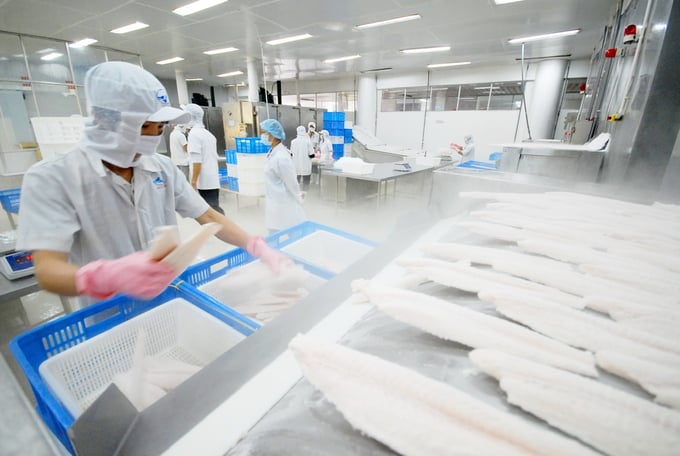November 27, 2025 | 03:47 GMT +7
November 27, 2025 | 03:47 GMT +7
Hotline: 0913.378.918
November 27, 2025 | 03:47 GMT +7
Hotline: 0913.378.918

Vietnam dominates the Singapore seafood market with frozen fish fillets and processed fish products. Photo: Hoang Vu.
The Vietnam Trade Office in Singapore has reported that according to the Singapore Business Management Agency, Singapore imported seafood from 100 countries and territories in the first quarter of this year. The total import turnover amounted to about 340 SGD, which represents a decrease of 5.67% compared to the previous year.
The seafood product group has an important share in the Singaporean market, with shrimp, crab, and crustaceans (HS0306) accounting for almost 25% of total market consumption. Fresh and chilled fish (HS0302) make up 19.86% of the market, while fillets of fish, fish meat, frozen or chilled (HS0304) account for 18.15%. Frozen fish (HS0303) represent 15.45% of the market, and mollusks (HS0307) make up 11.02%. The fresh fish, processed fish, and aquatic invertebrates product categories have relatively low market shares, namely 4.05%, 4.11%, and 2.43% correspondingly.
Malaysia remains the largest seafood exporting country to the Singaporean market among the top 15, with Norway in second place, Indonesia in third, China in fourth, and Vietnam surpassing Japan for the first time to secure the fifth position as a significant seafood exporting partner to the Singaporean market.
Statistics indicate that the seafood market share in Singapore is fairly divided across trade partners, with each nation having its specific strengths in exports. More precisely, the market share of the six nations with the highest market share ranges from 9% to 13%. More precisely, the percentages of Malaysia 13.6%, Norway 11.45%, Indonesia 11.13%, China, Vietnam, and Japan are, 10.15%, 8.58%, and 8.34% respectively. Nevertheless, every nation has its own specific products and exercises control in certain market categories.
Malaysia has exceptional performance in the production and sale of live fresh fish, shrimp, crabs, and crustaceans. It holds a significant market share of 28.34% in the live fresh fish sector and 21.30% in the shrimp, crabs, and crustaceans segment. Norway and Spain have exceptional proficiency in the production of refrigerated and frozen fresh fish items. China dominates the market for soft seafood goods, with a 35.62% market share, while Japan leads in aquatic invertebrate products with a 41.77% market share. Vietnam has a significant presence in the Singaporean seafood industry, particularly in the categories of frozen fish fillets, which make up 26.85% of the market, and processed fish, which account for 16.88%.
The remaining market share is equally spread among over 90 additional partners, such as Chile, India, Australia, Thailand, and the United States,etc.
Vietnam's seafood exports to Singapore had a turnover of over 24 million SGD in the first quarter of 2024, marking a 3.22% growth compared to the same period in the previous year.
In Q1 2024, Vietnam overcome Japan, climbing from the 6th to the 5th place as Singapore's biggest seafood exporting partner.
According to Mr. Cao Xuan Thang, the Trade Counselor and Head of the Vietnam Trade Office in Singapore, Singapore actively pursues a diversified supply strategy by consistently seeking, expanding, and diversifying its import markets via several means. This guarantees the security of Singapore's food supply, but it also increases the level of competition among nations that export seafood to Singapore.
Furthermore, the rising inflation presents a substantial obstacle for exporting nations, such as Vietnam, in the seafood business when it comes to selling their products to Singapore. The nation that can use its logistical advantages and reduce expenses will have a significant competitive advantage in exporting products to Singapore.
Statistical data clearly illustrates the prominent position and function of Vietnam's seafood in the Singaporean market. In order to improve seafood exports to Singapore and the world market as a whole, the Vietnam Trade Office in Singapore recommends that Vietnamese seafood companies do thorough research and make efficient use of the advantages provided by the Free Trade Agreements (FTAs) that Vietnam is a part of.
Consistently revise Singapore's rules, particularly those pertaining to quality standards, labeling requirements, etc.
Engage actively in trade fairs and exhibits to boost brand marketing, product promotion, and expand the presence of Vietnamese products in the global market. This will promote competitiveness and ensure consistent product quality and reputation with foreign partners.
Exercise prudence in confirming partner information before to signing contracts, managing products delivery, and making payments, in order to mitigate risks in commercial transactions.
Translated by Linh Linh

(VAN) China’s cooking oil is suddenly flooding into India. It all comes down to a soybean surplus that Beijing doesn’t quite know what to do with.

(VAN) An Giang promotes supply-demand connections, standardizes quality and builds value chains, creating a foundation for sustainable bird’s nest development and aiming to expand exports.
/2025/11/24/5339-4-nongnghiep-075331.jpg)
(VAN) Recently, the conference on 'Sustainable Fisheries Linkage Chain - Tilapia for Export' took place in Tien Hai commune, Hung Yen province.
/2025/11/21/4309-2-153400_128.jpg)
(VAN) Green and low-emission rice is paving the way for Vietnamese rice to enter high-end markets, marking the beginning of a transformation journey toward greening and elevating the national rice brand.

(VAN) ‘Right to Win’ outlines a national action plan that shapes a new vision for Viet Nam’s agriculture in an era of renewal and global integration.

(VAN) Lam Dong’s farmed sturgeon output this year is expected to reach 2,300 tons, worth VND 450 billion, affirming the brand’s position on the market.

(VAN) A surge in Ukrainian egg exports, largely driven by soaring sales to the UK over the last few years, has notably pushed up egg prices on the domestic market.